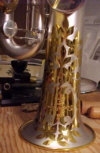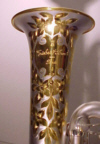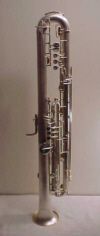
To the left are a number of thumbnail images. The first three we chose simply because, in our opinion, they are the most beautiful. The finish of the instrument is not original. We chose it to be satin silver with burnished highlights and 24 karat gold overlay. We chose this finish not only because it was so beautiful, but also to cover a host of sins perfomed by countless repairs enacted over the past 115 years.

This instrument was manufactured by Triebert & Cie. of France. Made in the early 1880's, about the time that Gautrot purchased the firm. This image demonstrates the artistry of the master engravers of the age.

Staying with the common theme of our desired finish, it is only appropriate to gold finish the inside of the bell. The original finish of this instrument was most likely raw brass.

The most challenging process to be performed during this restoration, hands down, was the fabricating of the water key u-tube. Completely BY HAND! Raised from flat brass sheet stock, the conical tube was formed and bent 180 degrees. The process took 10 VERY intense hours to complete.

The next several images are shown to emphasize the details addressed throughout the rebuilding of this instrument. The work involved called for the removal of ALL soldered components, i.e., posts, toneholes, guard mouldings and ferules.

With the removal of all soldered parts, we were able to concentrate on the smallest of defects in the body tubes. This allowed us to present a final finish to the instrument never imagined.

After all the tubes, bows and bell were complete, the arduous task of remounting all toneholes, posts, and other assorted bits and pieces could take place. In our shop, this process requires an emphasis on parallels and right angles. This ensures the instrument be dimensionally correct when completed.

After 115 years, you might think the keys would be pretty badly worn...and you'd be right! All key work was completely refitted and in many cases new metal was added at the worn ends to ensure a smooth, long lasting, precision fit.

Once the body had been reassembled (completely resodlered), very careful polishing was performed, with special emphasis on not overbuffing. Our attitude is that the instrument has made it 115 years, we want it to last at least another 115, so leave the metal on the horn!

The restoration of this bass sarrusophone employed a number of very talented artisans. Stephen McComas, Daniel Oberloh, Tom Green and the staff at Anderson Silver Plating Co, Inc. of Elkhart, Indiana. The restoration took place over a period of 18 months.
A note to the viewer: there has been a great deal of talk about refinishing brass instruments. Many have said: "to refinish is to ruin". Our attitude is: "Why would you want to do a restoration half way?" When this instrument arrived at our shop, it did work...barely. The owner, Michel Jolivet, wished the instrument be raised to a new glory, not only in its playability, but also in its aesthetic appeal. The process of refinishing instruments requires a mastery of metalworking ability, as well as a great deal of self-control. When done properly, an instrument should always play as well or better when leaving the shop then when it was new, given a good basic design. We would like to thank Dr. Jolivet for his patience, and trust in allowing us the opportunity to perform such a worthwhile task.

A side note: When it comes to double reeds, all of the beautiful pad work and plating won't do anything for the intonation if the bocal is not right. The original put the horn 20-40 cents flat, and caused it to lack in center. So, we made a new one.

The new bocal is fashioned after the original. It was produced primarily through the same technique, although we changed the length and taper ratio. Raised from flat brass sheet stock, the seam was silver braised and hand worked on a specially made steel mandrel. Telescopic tubing was fabricated for the receiver, and it was embossed with the company family name, after all, we designed and made it! Finally, it was finished in 24 karat gold.